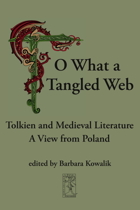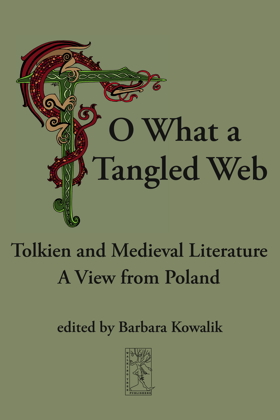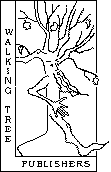O What a Tangled Web
Tolkien and Medieval Literature
A View from Poland
Barbara Kowalik (editor)
Cormarë Series No. 29

<--previous | all publications | next-->
how to buy this item
 The nine articles of stimulating literary criticism collected
in this volume view Tolkien's work from a variety of medieval
perspectives: the device of entrelacement employed in Arthurian
romances is used to throw light on the narrative design of The Lord
of the Rings; the cultures of Middle-earth are described with the
aid of medieval orality and literacy studies; the epic figure of the
queen is recalled to reveal the significance of women in Tolkien's
trilogy; the character of Éowyn is analyzed in terms of the epic
warrior code and the romance chivalric ethos; the role of Elbereth
is shown to correspond with the position of the Virgin Mary in
the world of medieval believers; the nature of evil is explored
through a comparison of Melkor to John Milton's Satan; allusions
to medieval Icelandic sagas are detected in Tolkien's works for
children; The Homecoming of Beorhtnoth is read in the light of The
Battle of Maldon; and Tolkien's literary art is illuminated by way
of his own critical essays on Beowulf and fairy-stories. Since all
the contributors come from Poland, the phenomenon of Tolkien's
prompt and enthusiastic Polish reception is briefly discussed in
the introductory chapter.
The nine articles of stimulating literary criticism collected
in this volume view Tolkien's work from a variety of medieval
perspectives: the device of entrelacement employed in Arthurian
romances is used to throw light on the narrative design of The Lord
of the Rings; the cultures of Middle-earth are described with the
aid of medieval orality and literacy studies; the epic figure of the
queen is recalled to reveal the significance of women in Tolkien's
trilogy; the character of Éowyn is analyzed in terms of the epic
warrior code and the romance chivalric ethos; the role of Elbereth
is shown to correspond with the position of the Virgin Mary in
the world of medieval believers; the nature of evil is explored
through a comparison of Melkor to John Milton's Satan; allusions
to medieval Icelandic sagas are detected in Tolkien's works for
children; The Homecoming of Beorhtnoth is read in the light of The
Battle of Maldon; and Tolkien's literary art is illuminated by way
of his own critical essays on Beowulf and fairy-stories. Since all
the contributors come from Poland, the phenomenon of Tolkien's
prompt and enthusiastic Polish reception is briefly discussed in
the introductory chapter.
table of contents | abstracts | cover | announcements | more

Barbara Kowalik
Introduction: Tolkien in Poland.
A Medievalist Liaison
1
Joanna Kokot
"O, what a tangled web we weave".
The Lord of the Rings and the Interlacement Technique
9
(abstract)
Bartłomiej Błaszkiewicz
Orality and Literacy in Middle-earth
29
(abstract)
Justyna Brzezińska
Rohan and the Social Codes of Heroic Epic and Chivalric Romance
47
(abstract)
Maria Błaszkiewicz
Tolkien's Queen Women in The Lord of the Rings
69
(abstract)
Barbara Kowalik
Elbereth the Star-Queen Seen in the Light of Medieval Marian Devotion
93
(abstract)
Katarzyna Blacharska
The Fallen: Milton's Satan and Tolkien's Melkor
115
(abstract)
Renata Leśniakiewicz-Drzymała
Berserkir, Bödvar Bjarki and the Dragon Fáfnir.
The Influence of Selected Medieval Icelandic Sagas
on Tolkien's Works for Children
145
(abstract)
Łukasz Neubauer
'He has gone to God glory seeking': Tolkien's Critique
of the Northern Courage and Rejection of the Traditional
Heroic Ethos in "The Homecoming of Beorhtnoth Beorhthelm's Son"
163
(abstract)
Andrzej Wicher
What Exactly Does Tolkien Argue for in "Beowulf:
The Monsters and the Critics?" An Attempt at a Metacriticism
179
(abstract)

Introduction: Tolkien in Poland.
A Medievalist Liaison
"O, what a tangled web we weave".
The Lord of the Rings and the Interlacement Technique
The references in J.R.R. Tolkien's The Lord of the Rings to Old English and Old Norse epic are numerous and conspicuous. There is yet another tradition underlying the text, though, namely that of the medieval chivalric romance, recognizable already in the motif of quest undertaken by Frodo and his companions in order to destroy the Ring. It is not only the type of action that suggests the affinities with the medieval genre, but also the compositional technique of interlacement, noticeable especially in the second volume of The Lord of the Rings. The paper examines the way in which particular subplots are interwoven after the breaking of the Fellowship of the Ring. As it appears, the compositional arrangement results not only in the creation of a complete world (as opposed to the open reality of the Arthurian romances), but also suggests an order underlying the seemingly chaotic world, at the same time suggesting an analogy between the created universe and the text in which it is retold.
Orality and Literacy in Middle-earth
The paper deals with the interplay of the cultural and literary traditions represented by the modes of orality and literacy in the secondary world created by J.R.R. Tolkien for The Lord of the Rings. The pursued argument stems from the standard methodology developed within the oral-formulaic theory in medieval studies. The theory is first applied to trace the interconnections between the oral and literate modes of social and cultural interaction in the culture of the Elves, and the paper presents the uniqueness of the elvish culture in this respect, which results mostly from the extreme longevity of the species. Subsequently the analysis focuses the influence of the culture of the various elvish tribes upon the other species inhabiting Middle-earth such as the Ents, who represent a culture of primary orality, through the humans (the people of Gondor as well as the Rohirrim), up to the Hobbits, whose largely literate culture incorporates elements of secondary orality. Finally, the paper discusses the question of oral literary composition and performance as practised in Middle-earth comparing the traditions represented by the various species to those known in the primary world.
Rohan and the Social Codes of Heroic Epic and Chivalric Romance
While writing The Lord of the Rings J.R.R. Tolkien drew inspiration from numerous literary and historical sources. The ideas for many of the characters and races he has created can be traced back to specific, mostly medieval, literary genres. A number of critics, among them such great authorities in the field of Tolkien studies as Tom Shippey, claim that the Rohirrim descend from the heroes of Anglo-Saxon poetry. I survey the arguments in favour of the Anglo-Saxon roots of the Rohirrim society, but I also point out that the Rohirrim are progressing from the heroic towards the chivalric model of society. I demonstrate that their culture incorporates many elements stemming from heroic culture which were later to become characteristic of the chivalric culture of the High Middle Ages, including the rituals of dubbing the knight and the office of the viceroy in place of an absent monarch. I suggest that, while still held together mainly by the values of kinship and honour, Rohan is a society in which a culture of the medieval chivalric type is also manifest. In the analysis of the heroes of Rohan special attention is given in the paper to the complexity of the character of Éowyn, particularly her inner conflict between duty towards her kin and people and the heroic desire for personal glory.
Tolkien's Queen Women in The Lord of the Rings
The paper explores the possibility of accounting for the alleged absence and/or insignificance of women in The Lord of the Rings. Starting from the full admission of the fact that women in The Lord of the Rings are almost absent, the paper endeavours to view this absence neither as a sign of the author's prejudice nor his failure as a writer, but as a conscious design the purpose of which is not to diminish the importance of the female element but, on the contrary, to glorify it. This task is attempted on the basis of the analysis of the significance of the figure of the queen, especially in the context of the fertility myth, for the overall pattern and meaning of Tolkien's literary output based on the relevant epic topoi including the omphalic space and heroic intrusion. As a result, the spatial and thematic connection between the presence or absence of a female figure and evil is revealed, placing The Lord of the Rings in a unique position among Tolkien's works where such a design, although hinted at, is never repeated in this form.
Elbereth the Star-Queen Seen in the Light of Medieval Marian Devotion
Even though the Catholic tinge of Middle-earth has been recognized by critics like Joseph Pearce and acknowledged by Tolkien himself, the affinity of Varda/Elbereth with Mary has not been explored, and this is, therefore, what this paper purports to do, particularly in the context of Tolkien's medievalist background, for the 'interpretatio mediaevalia' is inevitably connected with the 'interpretatio catholica' or 'interpretatio christiana', as Thomas Honegger points out (50). The heroes of Tolkien's trilogy repeatedly invoke Elbereth at various pivotal points of their anti-quest of the Ring, so Elbereth's role of supernatural aide and patroness of Middle-earth, strikingly parallel to the protective guidance of the Virgin Mary in medieval Christendom, is clearly underlined. The paper embraces the simplest and most plausible explanation of Elbereth's position, linking it to Tolkien's personal Marian devotion, which in turn must have been coloured and reinforced by his immersion in medieval literature. In the following discussion references are made to medieval liturgy, theology, and poetry, including a variety of literary genres, such as Old English metrical charms and Middle English lyrics, romances, gestes, and miracles of the Virgin.
The Fallen: Milton's Satan and Tolkien's Melkor
This paper presents an analysis of the depiction of Melkor in The Silmarillion (1977) by J.R.R. Tolkien and focuses on one aspect: the similarity between the fallen Ainur and the Devil of John Milton's Paradise Lost (1667). The aim is to demonstrate that while creating the figure of Melkor Tolkien not only followed the scriptural tradition but was also influenced by Milton's epic to a great extent.
The following paper deals with the impact of selected medieval Icelandic sagas on Tolkien's minor works which are usually considered to have been written for children, such as The Hobbit, The Adventures of Tom Bombadil and Farmer Giles of Ham. The paper starts with an analysis of the character of Beorn and compares his unpredictable mood and ability to change skin with the attributes of the Norse warriors known as the berserkir. Afterwards parallels are drawn between Smaug and Fáfnir of the Völsunga saga, proving that the character of Tolkien's dragon was deeply influenced by the description of the Norse beast. The subsequent subject of consideration concerns some references to the Völsung legend that are present in the collection of Tolkien's poems, The Adventures of Tom Bombadil. Finally the description of Giles' arrival at the dragon's lair is compared with the analogous scene from the Völsunga saga, leading to the general conclusion that Tolkien's wide knowledge of the Norse literature and language allowed him to refashion many forgotten motifs from the old sagas and use them in some of his own minor works, labeled as mere children's stories but in fact revealing a considerable degree of sophistication.
The article examines one of the lesser known works of J.R.R. Tolkien, his 1953 post-combat sequel to The Battle of Maldon written in the form of an alliterative dialogue. While it is clearly overshadowed by his more famous epic works, "The Homecoming of Beorhtnoth" and its two accompanying essays cannot be ignored for their great philological depth and precision of critical analysis. In fact, the impact it has had on The Battle of Maldon scholarship since 1953 is frequently compared to that of Tolkien's other ground-breaking work, his earlier essay on Beowulf, which in so many ways opened the eyes of scholarly commentators to the genuine literary value of the poem. In "The Homecoming" Tolkien appears to put his own words of critique in the mouths of two solitary figures plodding through the corpse-strewn battlefield in search of their fallen lord's body. In this way, the writer implicitly succeeds in voicing his moral disapproval of what he aptly refers to as the 'northern heroic spirit', a highly distinctive trait (or, rather, 'defect') of character which is all too often almost uncritically accepted as an archetypal representation of the famed reckless heroism in early Germanic literature.
The present paper tries, first of all, to define the scope of J. R. R. Tolkien's achievement in his famous essay "Beowulf: The Monsters and the Critics", and also to consider the possibility of regarding this essay as an incomplete success in defending the value of the poem in question. According to the author of the paper, Tolkien's strategy is basically to admit the existence of specific limitations and deficiencies in the Old English poem, and then argue that those very deficiencies, in the context of the poem, should be regarded as strengths rather than as weaknesses. This appears to open a new perspective on existentialist, or quasi-existentialist, ramifications of Tolkien's thought, and may also call for a new way of looking at Tolkien's own works, and particularly at The Lord of the Rings. The paper includes also a brief analysis of Tolkien's theoretical essay "On Fairy-Stories", which shows that the approach to Beowulf shown in "Beowulf: The Monsters and the Critics" is only a symptom of Tolkien's general attitude to literature, and to life, an attitude that is typified by attention to detail and respect for the feelings and intentions of other people, provided they are not ruthless manipulators. From this we may also derive Tolkien's conception of magic in his books, where magic is not an independent force but rather an aspect of a character's personality.


The illuminated capital on the cover was drawn by Anke Eißmann.
(link to Anke Eißmann's website)

Book reviews in Inklings Jahrbuch (22nd June 2015)
O What a Tangled Web reviewed in Beyond Bree (10th September 2013)
O What a Tangled Web, Tolkien and Medieval Literature, A View from Poland (23rd June 2013)
Upcoming publications (5th April 2013)

196 pages, Walking Tree Publishers 2013, Cormarë Series No. 29, Editor: Barbara Kowalik
, ISBN: 978-3-905703-29-0.

<--previous | all publications | next-->
how to buy this item

More on O What a Tangled Web Tolkien and Medieval Literature A View from Poland

terms and conditions
visitors since 23.06.13
last updated 23.06.13
